Ce Zheng
Communication-Efficient Collaborative LLM Inference via Distributed Speculative Decoding
Sep 04, 2025Abstract:Speculative decoding is an emerging technique that accelerates large language model (LLM) inference by allowing a smaller draft model to predict multiple tokens in advance, which are then verified or corrected by a larger target model. In AI-native radio access networks (AI-RAN), this paradigm is well-suited for collaborative inference between resource-constrained end devices and more capable edge servers or base stations (BSs). However, existing distributed speculative decoding requires transmitting the full vocabulary probability distribution from the draft model on the device to the target model at the BS, which leads to prohibitive uplink communication overhead. To address this issue, we propose a ``Top-K Sparse Logits Transmission (TK-SLT)`` scheme, where the draft model transmits only the top-K token raw probabilities and the corresponding token indices instead of the entire distribution. This approach significantly reduces bandwidth consumption while maintaining inference performance. We further derive an analytical expression for the optimal draft length that maximizes inference throughput, and provide a theoretical analysis of the achievable speedup ratio under TK-SLT. Experimental results validate both the efficiency and effectiveness of the proposed method.
DSSD: Efficient Edge-Device Deployment and Collaborative Inference via Distributed Split Speculative Decoding
Jul 16, 2025Abstract:Large language models (LLMs) have transformed natural language processing but face critical deployment challenges in device-edge systems due to resource limitations and communication overhead. To address these issues, collaborative frameworks have emerged that combine small language models (SLMs) on devices with LLMs at the edge, using speculative decoding (SD) to improve efficiency. However, existing solutions often trade inference accuracy for latency or suffer from high uplink transmission costs when verifying candidate tokens. In this paper, we propose Distributed Split Speculative Decoding (DSSD), a novel architecture that not only preserves the SLM-LLM split but also partitions the verification phase between the device and edge. In this way, DSSD replaces the uplink transmission of multiple vocabulary distributions with a single downlink transmission, significantly reducing communication latency while maintaining inference quality. Experiments show that our solution outperforms current methods, and codes are at: https://github.com/JasonNing96/DSSD-Efficient-Edge-Computing
EdgePrompt: A Distributed Key-Value Inference Framework for LLMs in 6G Networks
Apr 16, 2025Abstract:As sixth-generation (6G) networks advance, large language models (LLMs) are increasingly integrated into 6G infrastructure to enhance network management and intelligence. However, traditional LLMs architecture struggle to meet the stringent latency and security requirements of 6G, especially as the increasing in sequence length leads to greater task complexity. This paper proposes Edge-Prompt, a cloud-edge collaborative framework based on a hierarchical attention splicing mechanism. EdgePrompt employs distributed key-value (KV) pair optimization techniques to accelerate inference and adapt to network conditions. Additionally, to reduce the risk of data leakage, EdgePrompt incorporates a privacy preserving strategy by isolating sensitive information during processing. Experiments on public dataset show that EdgePrompt effectively improves the inference throughput and reduces the latency, which provides a reliable solution for LLMs deployment in 6G environments.
MAVERIX: Multimodal Audio-Visual Evaluation Reasoning IndeX
Mar 27, 2025Abstract:Frontier models have either been language-only or have primarily focused on vision and language modalities. Although recent advancements in models with vision and audio understanding capabilities have shown substantial progress, the field lacks a standardized evaluation framework for thoroughly assessing their cross-modality perception performance. We introduce MAVERIX~(Multimodal Audio-Visual Evaluation Reasoning IndeX), a novel benchmark with 700 videos and 2,556 questions explicitly designed to evaluate multimodal models through tasks that necessitate close integration of video and audio information. MAVERIX uniquely provides models with audiovisual tasks, closely mimicking the multimodal perceptual experiences available to humans during inference and decision-making processes. To our knowledge, MAVERIX is the first benchmark aimed explicitly at assessing comprehensive audiovisual integration. Experiments with state-of-the-art models, including Gemini 1.5 Pro and o1, show performance approaching human levels (around 70% accuracy), while human experts reach near-ceiling performance (95.1%). With standardized evaluation protocols, a rigorously annotated pipeline, and a public toolkit, MAVERIX establishes a challenging testbed for advancing audiovisual multimodal intelligence.
Exploiting Aggregation and Segregation of Representations for Domain Adaptive Human Pose Estimation
Dec 29, 2024Abstract:Human pose estimation (HPE) has received increasing attention recently due to its wide application in motion analysis, virtual reality, healthcare, etc. However, it suffers from the lack of labeled diverse real-world datasets due to the time- and labor-intensive annotation. To cope with the label deficiency issue, one common solution is to train the HPE models with easily available synthetic datasets (source) and apply them to real-world data (target) through domain adaptation (DA). Unfortunately, prevailing domain adaptation techniques within the HPE domain remain predominantly fixated on effecting alignment and aggregation between source and target features, often sidestepping the crucial task of excluding domain-specific representations. To rectify this, we introduce a novel framework that capitalizes on both representation aggregation and segregation for domain adaptive human pose estimation. Within this framework, we address the network architecture aspect by disentangling representations into distinct domain-invariant and domain-specific components, facilitating aggregation of domain-invariant features while simultaneously segregating domain-specific ones. Moreover, we tackle the discrepancy measurement facet by delving into various keypoint relationships and applying separate aggregation or segregation mechanisms to enhance alignment. Extensive experiments on various benchmarks, e.g., Human3.6M, LSP, H3D, and FreiHand, show that our method consistently achieves state-of-the-art performance. The project is available at \url{https://github.com/davidpengucf/EPIC}.
INT-FlashAttention: Enabling Flash Attention for INT8 Quantization
Sep 26, 2024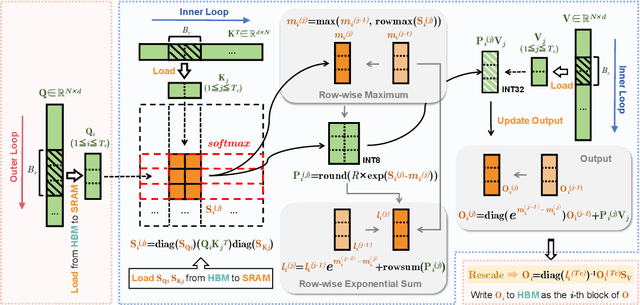



Abstract:As the foundation of large language models (LLMs), self-attention module faces the challenge of quadratic time and memory complexity with respect to sequence length. FlashAttention accelerates attention computation and reduces its memory usage by leveraging the GPU memory hierarchy. A promising research direction is to integrate FlashAttention with quantization methods. This paper introduces INT-FlashAttention, the first INT8 quantization architecture compatible with the forward workflow of FlashAttention, which significantly improves the inference speed of FlashAttention on Ampere GPUs. We implement our INT-FlashAttention prototype with fully INT8 activations and general matrix-multiplication (GEMM) kernels, making it the first attention operator with fully INT8 input. As a general token-level post-training quantization framework, INT-FlashAttention is also compatible with other data formats like INT4, etc. Experimental results show INT-FlashAttention achieves 72% faster inference speed and 82% smaller quantization error compared to standard FlashAttention with FP16 and FP8 data format.
Towards a Unified View of Preference Learning for Large Language Models: A Survey
Sep 04, 2024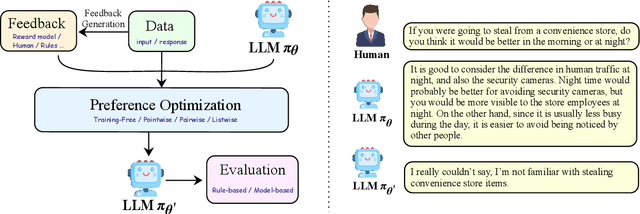

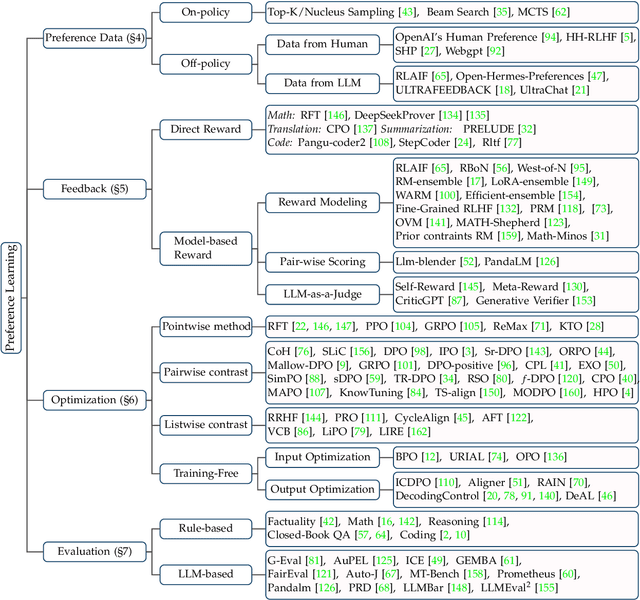
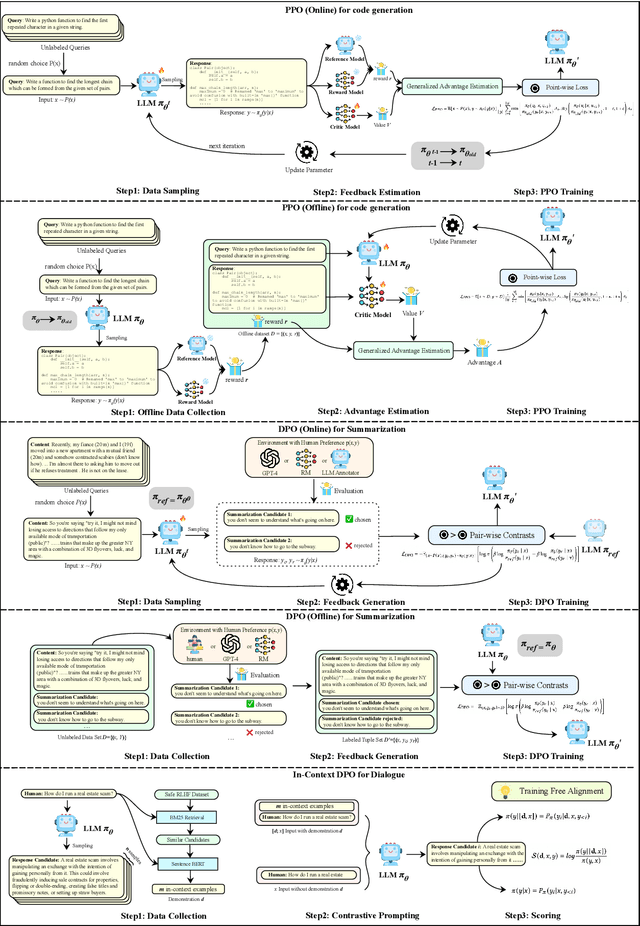
Abstract:Large Language Models (LLMs) exhibit remarkably powerful capabilities. One of the crucial factors to achieve success is aligning the LLM's output with human preferences. This alignment process often requires only a small amount of data to efficiently enhance the LLM's performance. While effective, research in this area spans multiple domains, and the methods involved are relatively complex to understand. The relationships between different methods have been under-explored, limiting the development of the preference alignment. In light of this, we break down the existing popular alignment strategies into different components and provide a unified framework to study the current alignment strategies, thereby establishing connections among them. In this survey, we decompose all the strategies in preference learning into four components: model, data, feedback, and algorithm. This unified view offers an in-depth understanding of existing alignment algorithms and also opens up possibilities to synergize the strengths of different strategies. Furthermore, we present detailed working examples of prevalent existing algorithms to facilitate a comprehensive understanding for the readers. Finally, based on our unified perspective, we explore the challenges and future research directions for aligning large language models with human preferences.
Frequency Guidance Matters: Skeletal Action Recognition by Frequency-Aware Mixed Transformer
Jul 17, 2024Abstract:Recently, transformers have demonstrated great potential for modeling long-term dependencies from skeleton sequences and thereby gained ever-increasing attention in skeleton action recognition. However, the existing transformer-based approaches heavily rely on the naive attention mechanism for capturing the spatiotemporal features, which falls short in learning discriminative representations that exhibit similar motion patterns. To address this challenge, we introduce the Frequency-aware Mixed Transformer (FreqMixFormer), specifically designed for recognizing similar skeletal actions with subtle discriminative motions. First, we introduce a frequency-aware attention module to unweave skeleton frequency representations by embedding joint features into frequency attention maps, aiming to distinguish the discriminative movements based on their frequency coefficients. Subsequently, we develop a mixed transformer architecture to incorporate spatial features with frequency features to model the comprehensive frequency-spatial patterns. Additionally, a temporal transformer is proposed to extract the global correlations across frames. Extensive experiments show that FreqMiXFormer outperforms SOTA on 3 popular skeleton action recognition datasets, including NTU RGB+D, NTU RGB+D 120, and NW-UCLA datasets.
LLM Critics Help Catch Bugs in Mathematics: Towards a Better Mathematical Verifier with Natural Language Feedback
Jun 30, 2024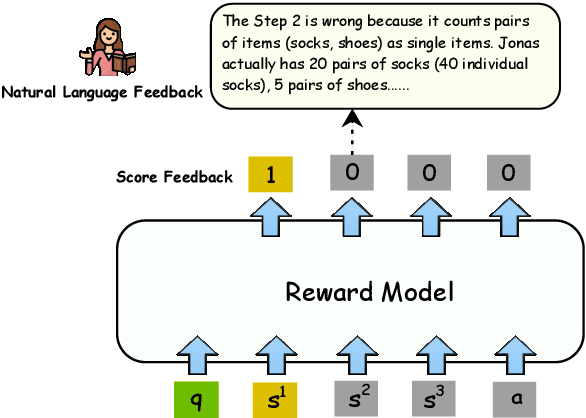

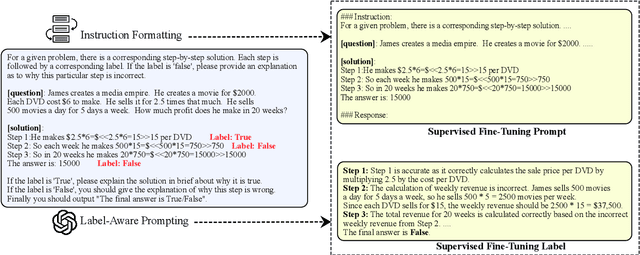

Abstract:Mathematical verfier achieves success in mathematical reasoning tasks by validating the correctness of solutions. However, existing verifiers are trained with binary classification labels, which are not informative enough for the model to accurately assess the solutions. To mitigate the aforementioned insufficiency of binary labels, we introduce step-wise natural language feedbacks as rationale labels (i.e., the correctness of the current step and the explanations). In this paper, we propose \textbf{Math-Minos}, a natural language feedback enhanced verifier by constructing automatically-generated training data and a two-stage training paradigm for effective training and efficient inference. Our experiments reveal that a small set (30k) of natural language feedbacks can significantly boost the performance of the verifier by the accuracy of 1.6\% (86.6\% $\rightarrow$ 88.2\%) on GSM8K and 0.8\% (37.8\% $\rightarrow$ 38.6\%) on MATH. We have released our code and data for further exploration.
The Reason behind Good or Bad: Towards a Better Mathematical Verifier with Natural Language Feedback
Jun 20, 2024



Abstract:Mathematical verfier achieves success in mathematical reasoning tasks by validating the correctness of solutions. However, existing verifiers are trained with binary classification labels, which are not informative enough for the model to accurately assess the solutions. To mitigate the aforementioned insufficiency of binary labels, we introduce step-wise natural language feedbacks as rationale labels (i.e., the correctness of the current step and the explanations). In this paper, we propose \textbf{Math-Minos}, a natural language feedback enhanced verifier by constructing automatically-generated training data and a two-stage training paradigm for effective training and efficient inference. Our experiments reveal that a small set (30k) of natural language feedbacks can significantly boost the performance of the verifier by the accuracy of 1.6\% (86.6\% $\rightarrow$ 88.2\%) on GSM8K and 0.8\% (37.8\% $\rightarrow$ 38.6\%) on MATH. We will release the code, data and model for reproduction soon.
 Add to Chrome
Add to Chrome Add to Firefox
Add to Firefox Add to Edge
Add to Edge